Monte Carlo Radiation, CT Scan CFD Simulation
$160.00 Student Discount
- The problem numerically simulates Computerized Tomography (CT) Scan using ANSYS Fluent software.
- We design the 3-D model with the Design Modeler software.
- We mesh the model with ANSYS Meshing software, and the element number equals 4390045.
- We use the Monte Carlo (MC) Radiation Model to define radiation heat transfer.
To Order Your Project or benefit from a CFD consultation, contact our experts via email ([email protected]), online support tab, or WhatsApp at +44 7443 197273.
There are some Free Products to check our service quality.
If you want the training video in another language instead of English, ask it via [email protected] after you buy the product.
Description
Computerized Tomography (CT) Scan, Radiation, Monte Carlo (MC), CFD Simulation, ANSYS Fluent, Tutorial
Description
In this project, we perform the numerical simulation of thermal radiation of rays in a computerized tomography (CT) scan using ANSYS Fluent software.
The current model is related to the patient’s body in a lying position, which is placed under the CT scan machine. In the upper part of the CT scan machine, a screen is considered a source of light radiation. This light radiation is transmitted into the patient and after passing through the human body, it sends a series of data on the screen in front of it, which causes the image to be displayed in computerized systems.
The aim of this project is to investigate the effect of radiation on the human body. If medical principles are not observed, the radiation of these light rays on the human body can be very dangerous. So controlling the amount of radiation is an important issue in the medical industry.
We designed the geometry of the model in 3D using Design Modeler software. The computational domain of the model is related to the interior space of a CT scan room. Inside this room, we design a CT scan machine, a bed, and a patient lying on the bed.
Then we meshed the model using ANYS Meshing software. The meshing is unstructured, and 4390045 cells are generated.
Monte Carlo Methodology
For this simulation, we used the radiation model to define radiation rays. Radiation heat transfer is one of the methods of heat transfer (such as conduction and convection). All materials at a certain temperature release heat from themselves to the environment, which is called radiation heat transfer. Radiation heat transfer is used in cases such as flame where there is a significant temperature in the medium.
There are different methods for the radiation model in ANSYS Fluent software. In this project, we use the Monte Carlo (MC) model. The mechanism of this method is based on the physical interaction between photons and their environment. In fact, a photon within the computational domain is tracked by the system until it reaches the annihilation step.
For the radiative transfer equation (RTE) in the MC method, it is assumed that the radiation intensity is proportional to the differential angular flux of photons. Also, the radiant heat flux is proportional to the rate of the incident of photons.
Monte Carlo Conclusion
After conclusion, we have obtained the contours related to volumetric absorbed radiation, incident radiation, radiation intensity, and radiation temperature changes.
We have presented these contours in two modes. In the first mode, we present the contours in the space above the patient’s body and below the radiation source of the CT scan device, so that we can investigate the radiation ray’s path from the CT scan device.
In the second mode, we have displayed the contours inside the patient’s body to check how the rays penetrate the patient’s body.
The results correctly show the radiation path of the rays from the source of the CT scan device. As the figures show, these rays enter the human body. So, the amount of these dangerous radiations in the human body can be medically important.
This CFD Project is the 7th episode of the Radiation Model Training Course.
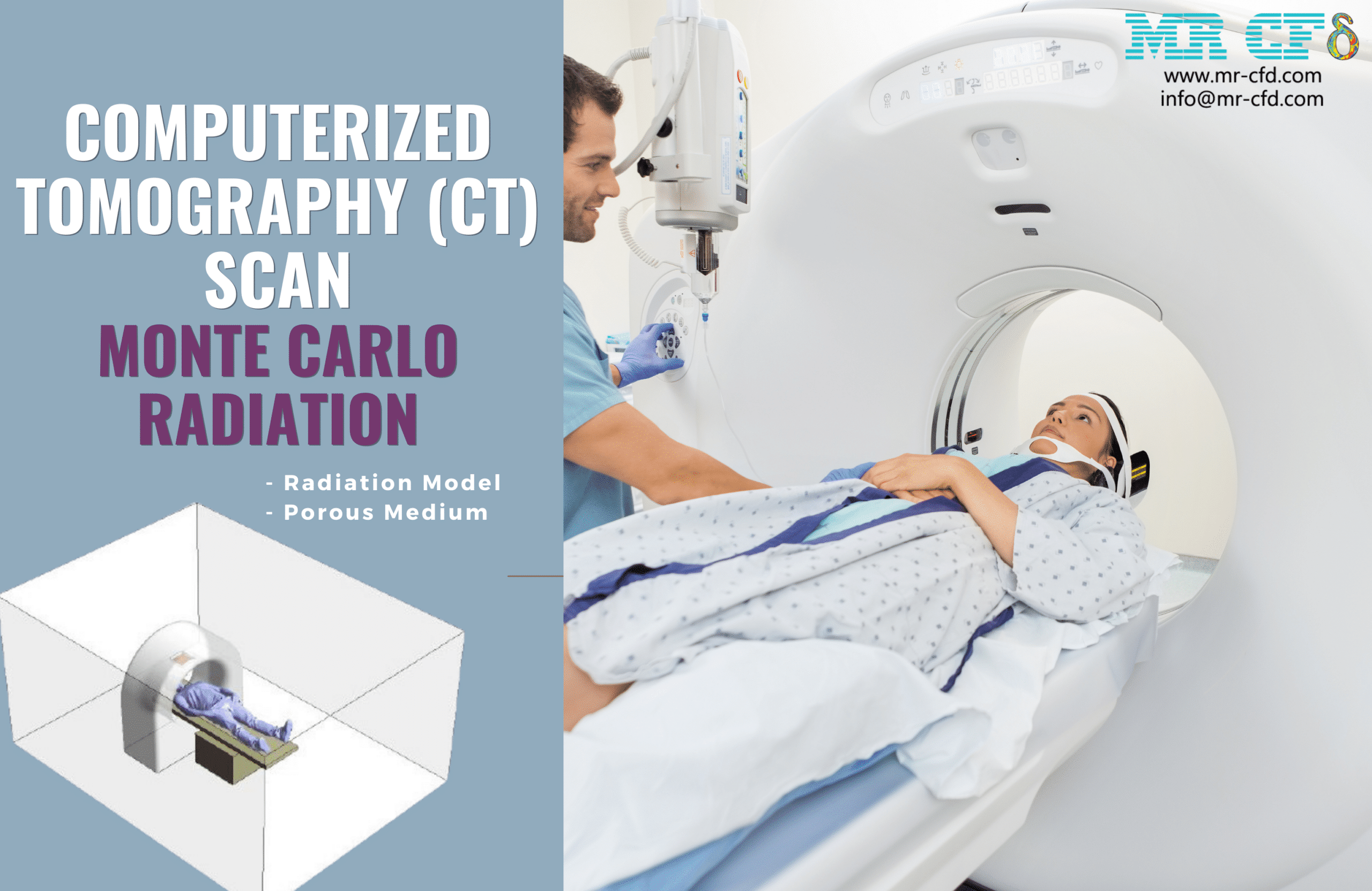
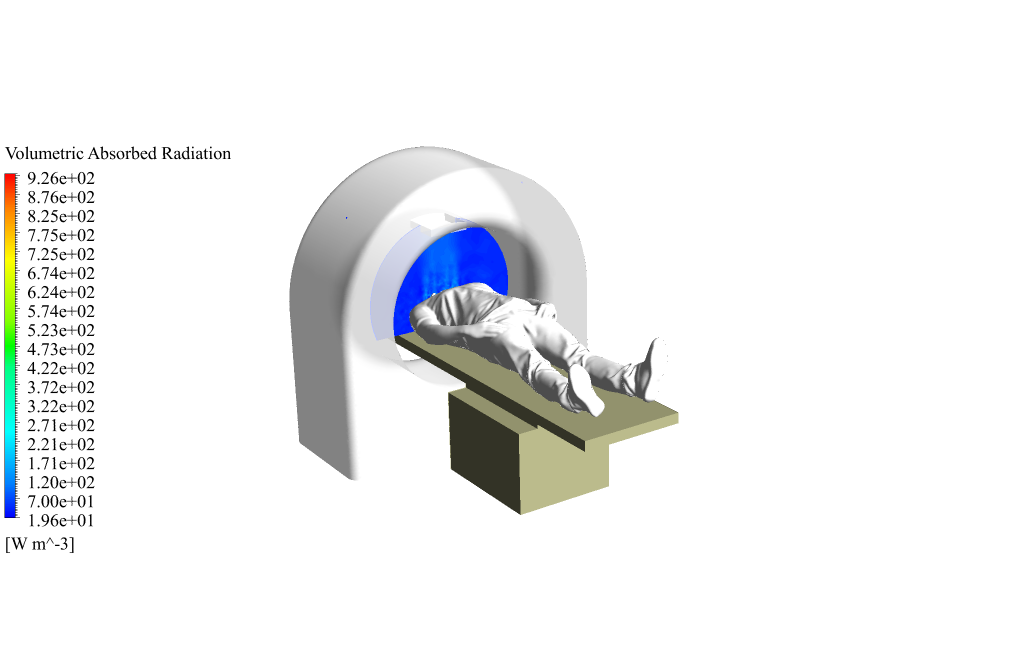
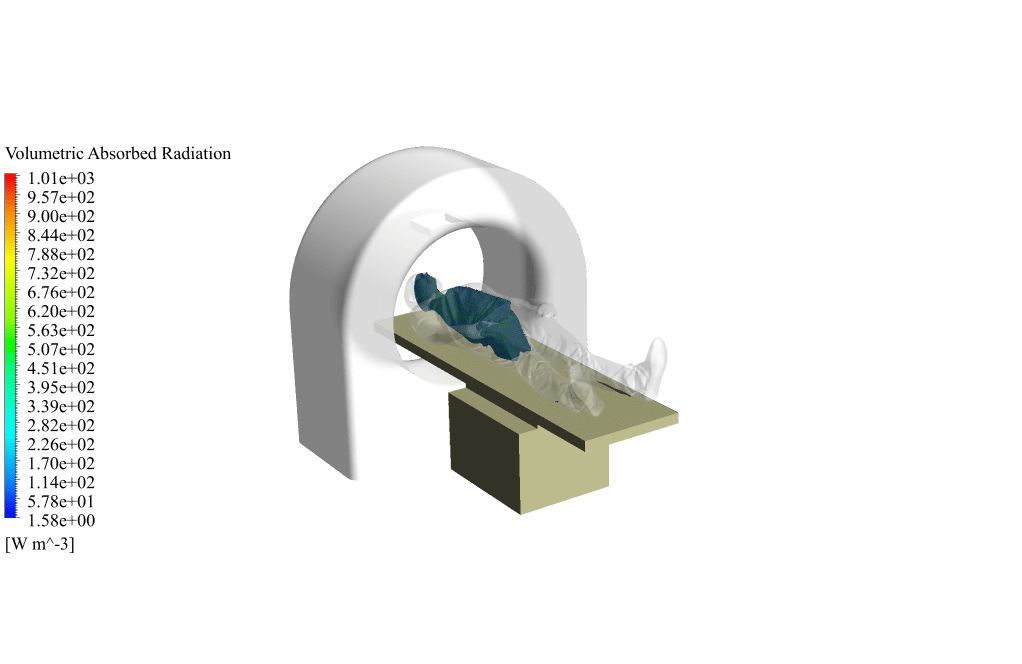
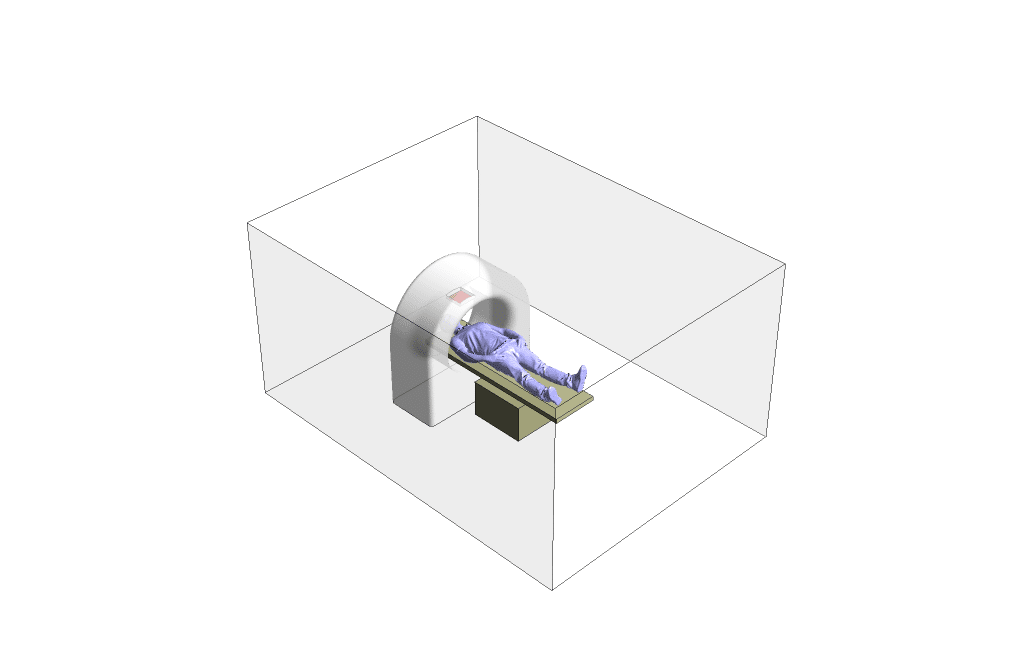
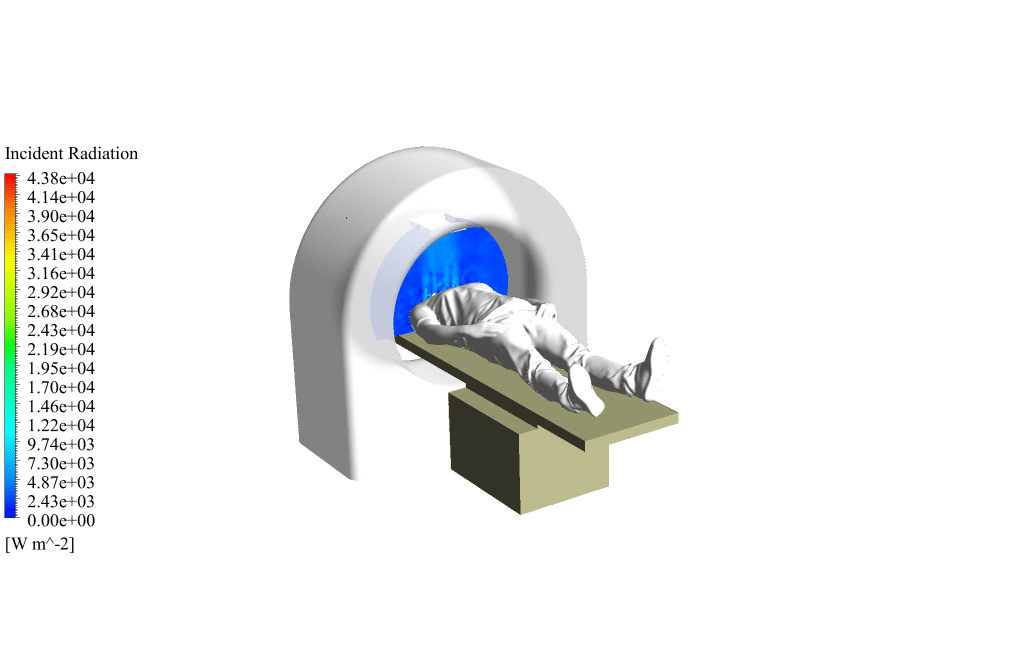
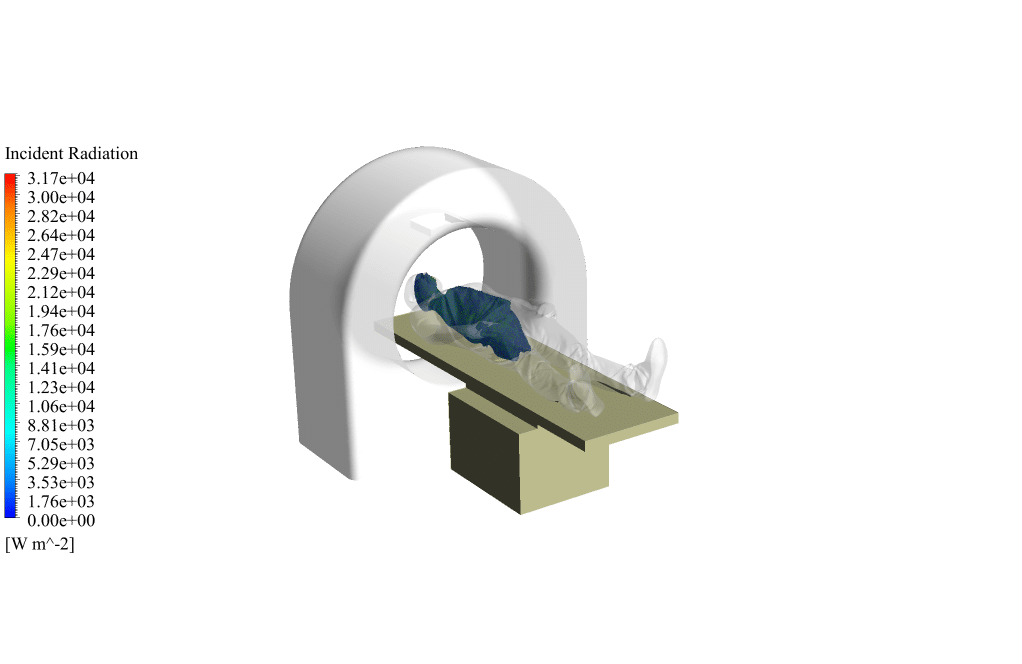
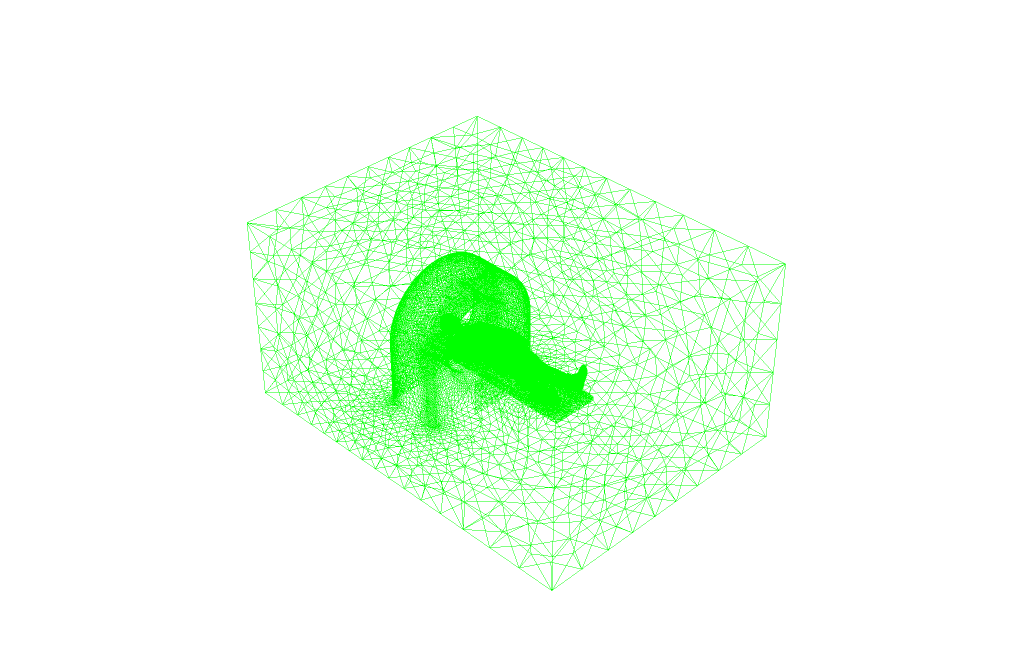
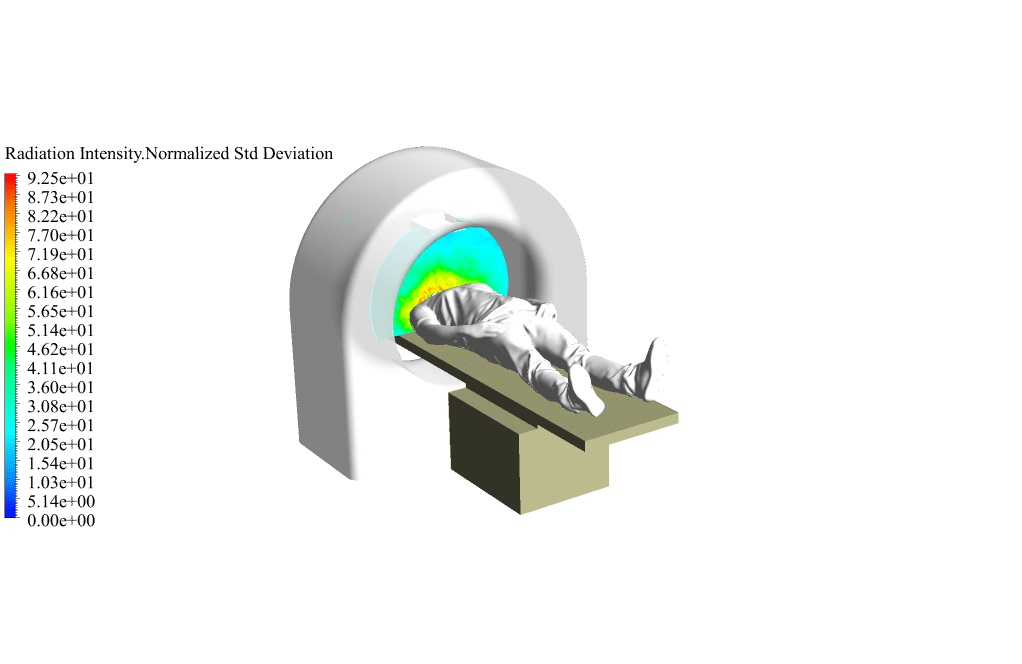
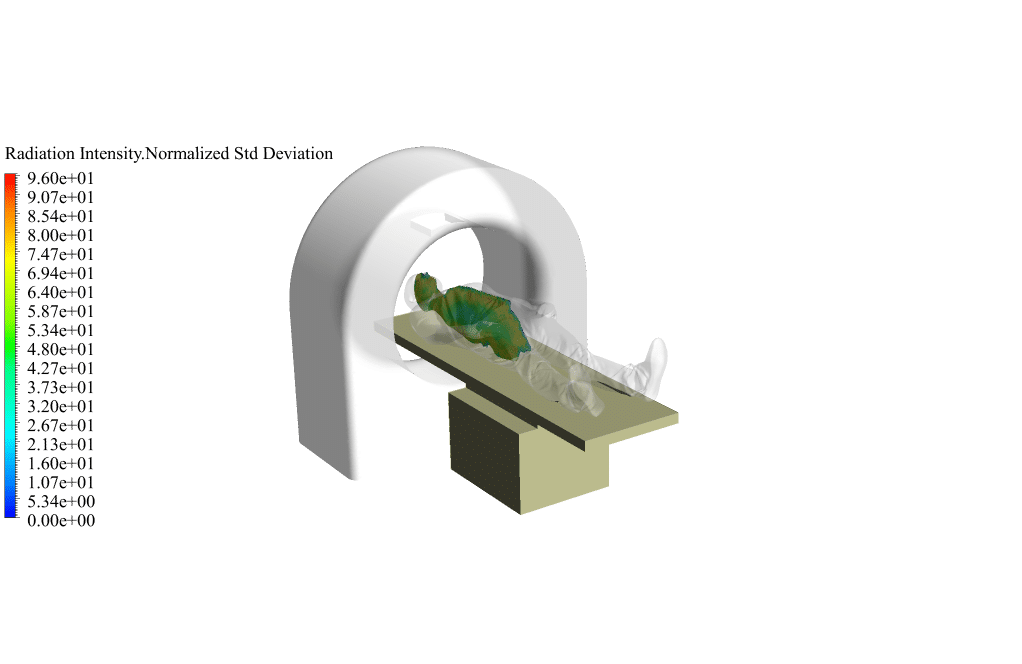
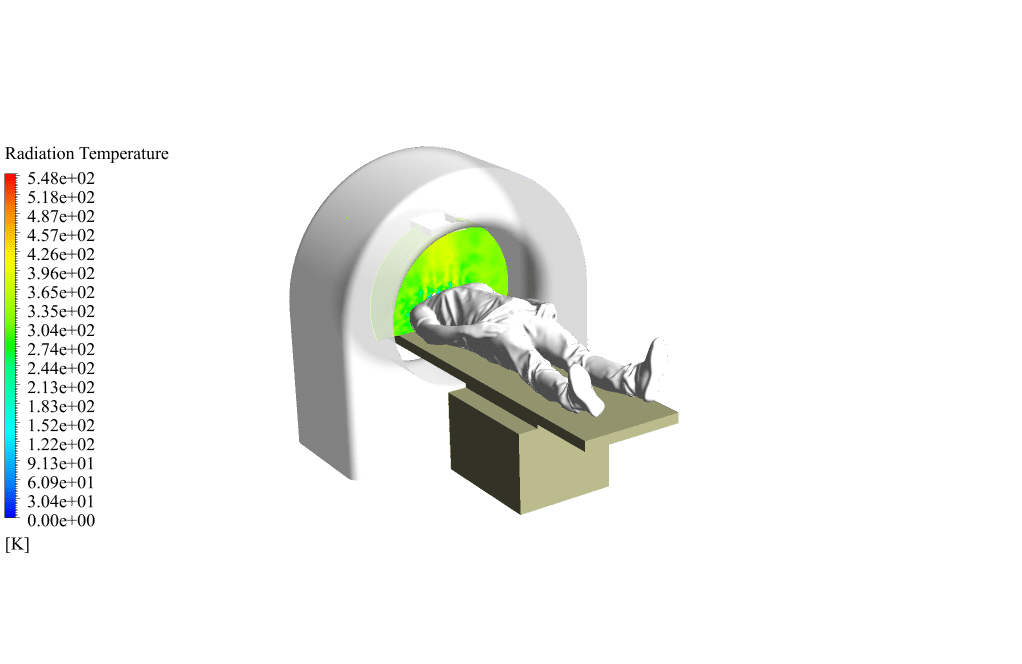
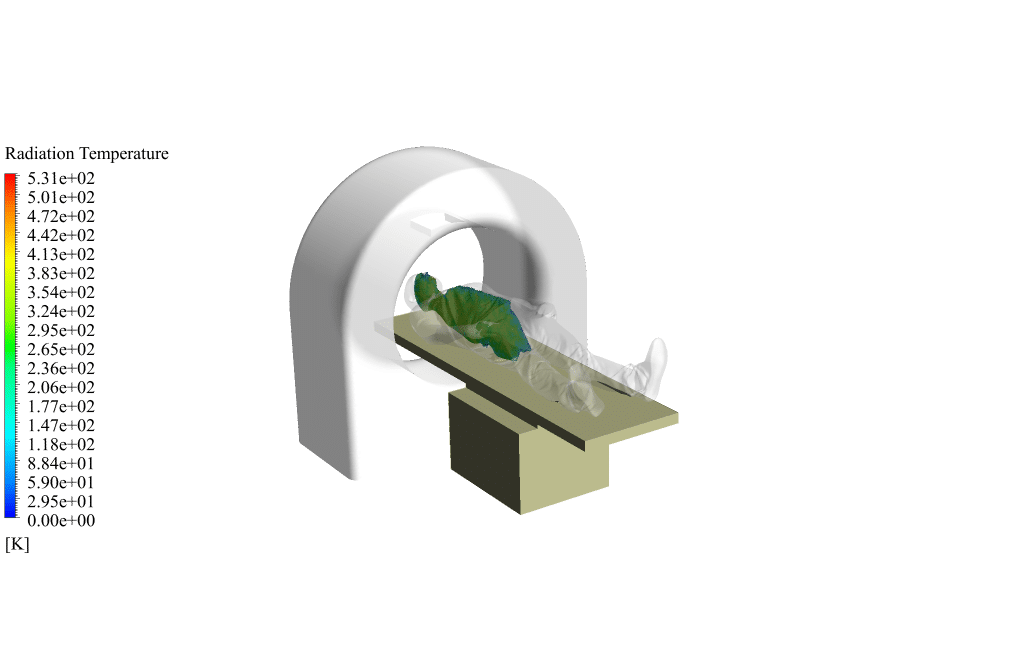



Heidi Prosacco –
Does the CFD simulation take into account different tissue densities? How does it model the variation in how radiation is absorbed by different parts of the body?
MR CFD Support –
In this CFD simulation, various tissue densities are taken into account by assigning different material properties within the human body model, which affect how radiation is absorbed. This is essential to mimic the different interactions of radiation with various tissues. The Monte Carlo (MC) method used in the simulation tracks the photons and calculates the absorbed dose in each tissue type based on its unique properties.
Florida Abbott –
This product was a really informative project! The detailed analysis on how CT scans affect the human body using CFD simulation was superb. I also appreciate the insightful visualization of the radiation paths. Great work!
MR CFD Support –
Thank you so much for your positive feedback! We’re delighted to hear that the project was informative and that the visualizations of the radiation paths were helpful in understanding the impact of CT scans on the human body. We are committed to providing high-quality simulations and educational content, and your satisfaction as a customer means a lot to us. If you have any further questions or need assistance with future projects, feel free to reach out. Thank you for choosing MR CFD Company’s learning products!
Cheyenne Brakus –
The explanation of the Monte Carlo methodology was quite thorough. I’m interested to know whether the radiation absorption by different tissues in the patient’s body, such as bones and organs, is simulated with varying densities? Also, is the impact on surrounding air and equipment also considered?
MR CFD Support –
In this CT Scan CFD simulation, varying densities of different tissues within the human body can indeed be accounted for through the definition of distinct absorption coefficients in the Monte Carlo radiation model. This ensures that the radiation absorption will realistically differ between tissues such as bone, organ tissues, and muscles. Regarding the impact on the surrounding air and equipment, these are also factors that can be incorporated into the simulation to understand secondary radiation effects and ensure a comprehensive safety analysis.
Mr. Ubaldo Mohr –
What are the safety measures considered regarding the radiation exposure during the simulation?
MR CFD Support –
In the CT scan CFD simulation, safety measures are embedded in the design of radiation limit values, the thickness of the barriers, and the arrangement of the machine components to minimize the radiation exposure to the patient. The simulation tracks and measures radiation intensity within safe limits, as defined by medical standards.
Dangelo Conroy MD –
This training course on CT scan radiation seems very detailed. Could you provide any insights on how this simulation helps maintain patient safety during a CT scan, apart from controlling the amount of radiation?
MR CFD Support –
The simulation helps maintain patient safety by allowing researchers and medical professionals to understand how radiation interacts with human tissue at a detailed level. By analyzing the penetration and dispersion of radiation through different body tissues, safety protocols can be established, such as optimizing the intensity and duration of exposure to minimize risk while still achieving clear images.
Prof. Flavie Conn –
Is the Monte Carlo method suitable for simulating all types of radiation in medical applications or are there scenarios where it wouldn’t be the best choice?
MR CFD Support –
The Monte Carlo method is generally suitable for simulating complex radiation interactions in medical applications like CT scans due to its ability to capture the stochastic nature of photon scattering and absorption. However, there could be situations where simpler or more specialized methods might be more appropriate, depending on the accuracy requirements and computational resources available.
Lelia Schimmel –
The tutorial was very comprehensive, but I am curious to know, does this simulation include different tissue densities when simulating the path of radiation through the human body?
MR CFD Support –
The simulation indeed takes into account the varying densities of tissues when simulating the path of radiation through the human body. Different materials in the patient’s body are set with unique absorption and scattering coefficients, which affect how the radiation interacts as it travels through, effectively modeling tissue heterogeneity.
Mrs. Neha Torphy III –
Is it possible to adjust the intensity of the radiation source in the simulation to represent different dosage levels, and if so, how is this done in the ANSYS Fluent software?
MR CFD Support –
Yes, it is possible to adjust the intensity of the radiation source in the simulation to represent different dosage levels. This is typically done in the boundary conditions for the radiation source, where you can specify the radiation intensity, often in terms of flux or power. In ANSYS Fluent’s Monte Carlo radiation model, you can modify these values before the simulation to investigate the effect of varying radiation doses.
Jillian Hills –
How precise is the Monte Carlo radiation model in simulating the rays’ interaction with the human body? Does it account for the different tissue densities and their impact on radiation absorption?
MR CFD Support –
The Monte Carlo radiation model is a sophisticated approach designed to simulate the complex interactions of radiation with various materials, including the human body. It effectively accounts for the changes in intensity as radiation passes through regions with different densities and compositions, such as tissues, bones, and organs, which impact the absorption and scattering of radiation. The results from this model help in accurately predicting the dose distribution within the body during a CT scan, thereby assisting in controlling the detrimental effects of exposure.
Ms. Cecilia Goldner –
The details of the Monte Carlo method are intriguing. Is the volumetric absorbed radiation experienced by the patient’s body during the scan within safe medical standards?
MR CFD Support –
Yes, the simulation ensures that the volumetric absorbed radiation experienced by the patient’s body is within safe medical limits. The project included a rigorous assessment to control the amount of radiation to prevent any harmful effects.
Torey VonRueden –
Can this CFD project simulate the difference in radiation absorption for various tissues in a patient’s body, such as bone versus muscle?
MR CFD Support –
In the CT Scan simulation, the Monte Carlo radiation model may be used to account for varying levels of radiation absorption in different tissues. Different absorption and scattering coefficients can be set for various materials (e.g., bone, muscle) to simulate the differential interaction of radiation with these tissues.
Domenic Murray III –
What safety precautions were observed in the simulation to ensure the levels of radiation were within safe limits?
MR CFD Support –
In this simulation, the safety precautions considered include setting the radiation intensity to levels typically within human tolerance for medical imaging. Additionally, the Monte Carlo Radiation model’s parameters were calibrated to mirror the standard operational procedures that minimize radiation exposure while allowing for accurate image capture. This is designed to study the behavior of radiation during the CT scan process and ensure the usage of radiation is safe and complies with medical standards.
Dr. Bernice Pfeffer –
I really appreciated the detailed explanations and beautiful visualizations provided in the CT scan radiation simulation tutorial. It helped me understand how medical imaging techniques can be simulated and gave me insight into the important safety considerations in medical radiation. Thank you for such an incredible learning resource!
MR CFD Support –
We’re thrilled to hear that our CT scan radiation simulation tutorial was both insightful and helpful for you! Understanding medical imaging simulations is crucial for safety in healthcare, and we’re glad that our content was able to contribute to your learning experience. Thank you for your positive feedback!
Ariel Altenwerth –
This product helped me a lot in my biomedical engineering studies, especially visualizing how CT scan radiation interacts with human tissues. What level of expertise is required to fully understand and utilize this CFD simulation training or is it beginner-friendly?
MR CFD Support –
Thank you for your kind feedback! We are thrilled to hear that our product has contributed to your studies. The CT Scan Radiation CFD Simulation is designed to cater to various levels of expertise. It is suitable for learners who have basic knowledge of the principles of CFD and radiation physics. However, the training comes with detailed step-by-step tutorial instructions, which make it quite accessible, even for beginners who are eager to learn. For those with more advanced skills, the simulation offers deeper insights into the specialized radiation model, particularly useful for biomedical applications like CT scans.
Marley Ullrich –
What validation procedures are used to confirm the accuracy of the simulation results in these medical applications?
MR CFD Support –
In medical applications like CT scan simulations, validation procedures typically involve comparing the CFD simulation results with actual experimental data or established numerical results from previous validated studies. Additionally, verification may be performed by checking specific metrics against recognized standards within the medical field, such as radiation dosage limits specified by health and safety guidelines.
Ms. Kavon Gaylord –
What type of radiation source is used in the CT Scan simulation, and how does this impact the patient’s body in terms of radiation exposure?
MR CFD Support –
In the CT Scan simulation, a screen in the upper part of the CT scan machine acts as the source of light radiation. This radiation passes through the patient’s body and the interaction with the body tissues provides data for imaging. It is crucial to control the amount of radiation to prevent dangerous exposure, which can be a medical concern. The simulation helps analyze the effective radiation dose a patient receives, thereby improving the safety and efficacy of CT scan procedures.
Prof. Marlon Lebsack I –
Is the Monte Carlo method used here capable of accurately modeling the interaction of radiation with complex biological tissue in the Monte Carlo Radiation CT Scan simulation?
MR CFD Support –
In the Monte Carlo Radiation CT Scan simulation, the Monte Carlo (MC) method applied can model the complex interactions of radiation with various materials. However, while the method is sophisticated, the accuracy in biological tissues’ modeling will also depend on the precision of the physical properties assigned to the simulated tissues. The MC method is a robust tool to predict how radiation travels and interacts, but validating the simulation against experimental data is essential for ensuring that it accurately represents what occurs in an actual CT scan scenario.
Mr. Cielo Toy –
I’m impressed with the detailing in the simulation! Can you test different levels of radiation exposure to see safe operating thresholds for medical practices?
MR CFD Support –
Absolutely! With this Monte Carlo Radiation CT Scan CFD simulation, we indeed have the capacity to test various levels of radiation exposure and evaluate the corresponding effects to ensure safety within medical practices.